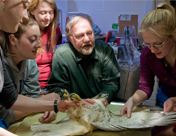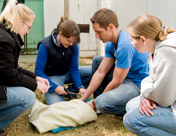Birds of Prey as Environmental Monitors and Tools for Learning
- James G. Sikarskie
- Associate Professor
- Department of Small Animal Clinic Sciences
- College of Veterinary Medicine

Dr. Jim Sikarskie and veterinary students Naomi Johnson, Kirsten Begin, Joann Swatek, and Allison Eavey examine the wing of a red-tailed hawk that was brought in for treatment of lead poisoning.
Growing up on a farm in the Upper Peninsula, Jim Sikarskie was accustomed to seeing birds of prey. His childhood dream was to become an ornithologist. He was struck by the dire statistics presented on the first Earth Day in 1970—that, based on estimates from shell thickness and pesticide use, many raptors (birds of prey) would be extinct by 2000. This stark data helped shape what would become his personal creed: "We have to accept the challenge of the future," he said.
Dr. Sikarskie has spent much of his life meeting this challenge. His involvement in projects at MSU has ranged from giving presentations at schools to recruiting students for degrees in wildlife management, rehabilitating injured wildlife, and judging wildlife art competitions. The funds from one such art program went into building outdoor flight pens for rehabilitating raptors.

Students Allison Eavey, Naomi Johnson, Trevor Moore, and Joann Swatek prepare to release a young eagle into an outdoor flight pen.
One of Sikarskie's best-known projects was the Wildlife Encounters program, which was created in the 1980s as a partnership between Dennis Laidler at Michigan United Conservation Clubs (MUCC) and MSU's College of Veterinary Medicine. The program used live animals that were permanently disabled—and therefore would not be able to survive in the wild—to teach about Michigan's wildlife and ecology. Laidler, now curator of educational programs at Lansing's Potter Park Zoo, credits Sikarskie with making the program happen. "His success, expertise, and reputation," Laidler said, "made the whole operation possible." Sikarskie estimated that approximately 100,000 children a year participated in this program, which lasted almost 20 years.
Sikarskie cited several reasons for the success of the program. "We are hardwired to be relaxed by the environment," he said, noting that "nature deficit disorder" (a term first used by Richard Louv in the book Last Child in the Woods) results in a number of behavioral problems. Live outreach with birds begins to address these issues. The animals grab the children's attention, "then they listen, and they learn something." Although a decline in overall membership, lack of funding, and a change of focus within MUCC resulted in the ending of the Wildlife Encounters program in January 2009, local organizations are continuing the work. At Potter Park Zoo, for example, Laidler said, "Because of Dr. Sikarskie's help in getting MUCC animals over here, we'll be able to add two presentations to our educational menu on Michigan wildlife diversity and Michigan birds of prey." Sikarskie himself plans to stay involved with MUCC as it begins a new program called "No Child Left Indoors."
"We are hardwired to be relaxed by the environment... 'nature deficit disorder' results in a number of behavioral problems. Live outreach with birds begins to address these issues; the animals grab the children's attention, then they listen and they learn something."
James G. Sikarskie
Sikarskie's other major project, "Systematic Environmental Assessment: Eagles Assess Global & Local Ecosystems" (SEA EAGLE), while much more recent than Wildlife Encounters, also stems from the wake-up call of Earth Day 1970. Sikarskie and Bill Bowerman, a former Ph.D. student who now teaches at Clemson University, are conducting research on the eight species of Haliaeetus (sea eagles), which include the bald eagle. Because sea eagles are at the top of the aquatic food chain, they make excellent biomonitors of contaminants such as mercury. By "drawing blood and pulling feathers," Sikarskie and Bowerman are able to measure the degree of contamination of the Great Lakes region, thus influencing policies such as fish consumption advisories for the region.
Although he's been at MSU for over 30 years, Sikarskie says he's nowhere near retiring. The "challenge of the future" is one he still embraces wholeheartedly. Since his youth, he has been "seeing things that I knew I was lucky to see, and wanting to be involved in preserving these things." He added, "I love what I do."
- Written by Lisa Eldrid, University Outreach and Engagement